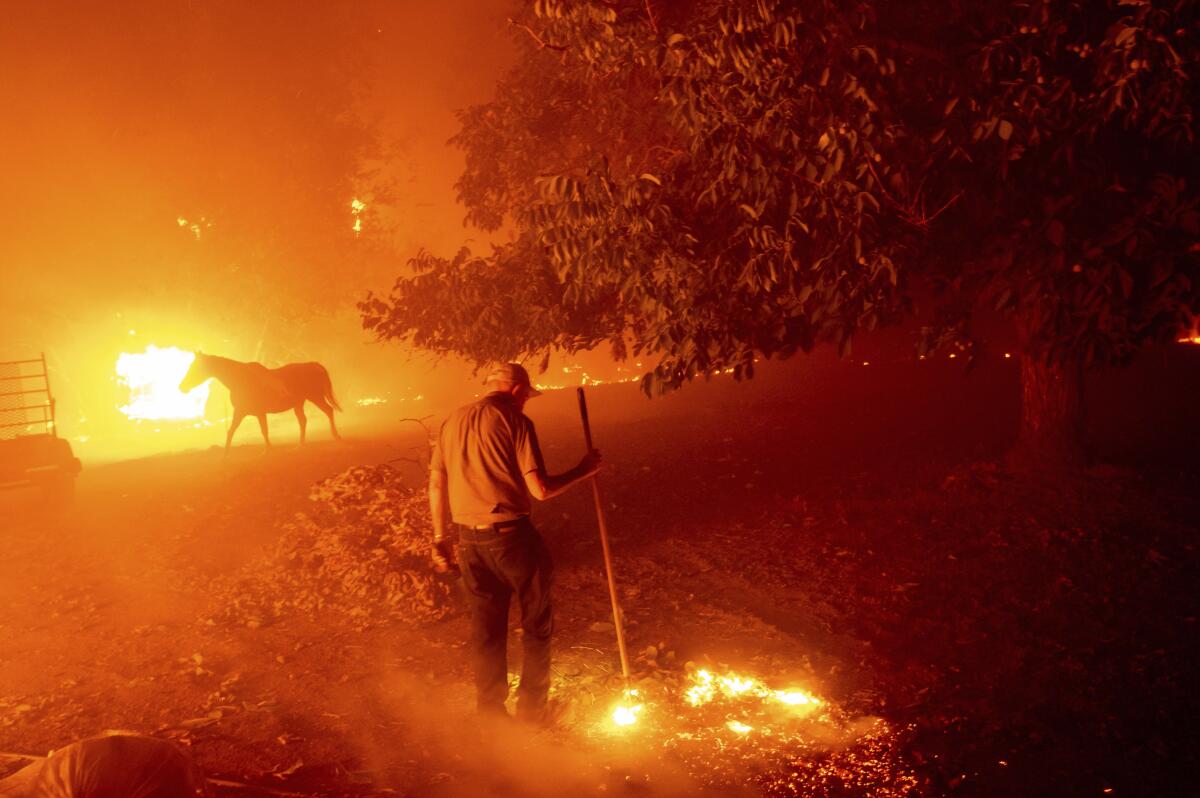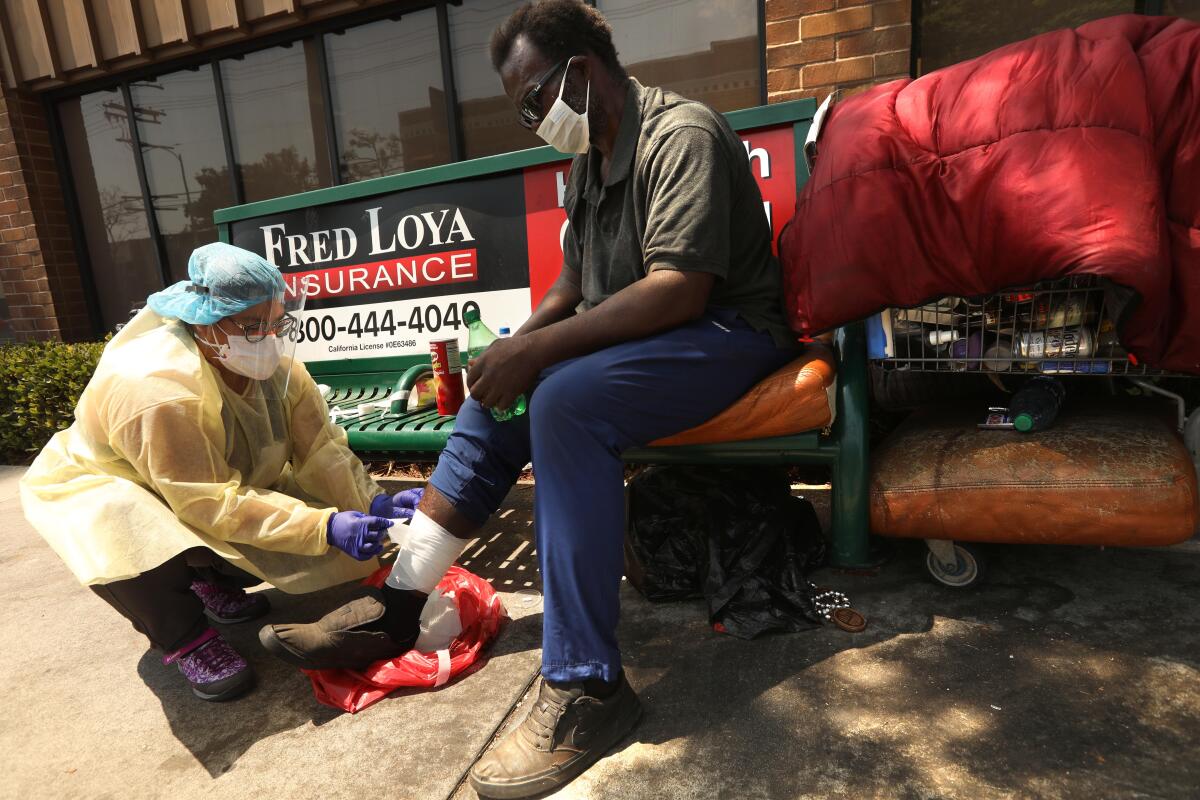Newsletter: Fires have already burned more acres statewide in 2020 than during all of 2019

- Share via
Good morning, and welcome to the Essential California newsletter. It’s Thursday, Aug. 20, and I’m writing from Los Angeles.
Sign up for Essential California
The most important California stories and recommendations in your inbox every morning.
You may occasionally receive promotional content from the Los Angeles Times.
It’s been an apocalyptic few days, even by California standards. Fueled by extraordinary weather conditions (officially 10,849 lightning strikes in a 72-hour period, record-breaking heat), fires have exploded across the state. Tens of thousands of Californians have had to evacuate, fleeing their homes while also navigating the added complications wrought by the pandemic.
[Read the story: “‘Not ordinary.’ Fires encircle Bay Area amid heat wave, forcing thousands to evacuate” in the Los Angeles Times]
“We are experiencing fires, the likes of which we haven’t seen in many, many years,” Gov. Gavin Newsom told Californians during a press conference Wednesday. He said that — as of the noon briefing — there were 367 known fires across the state, at least 23 of which were considered major. The briefing came a day after Newsom had declared an official statewide emergency.
According to the governor, the state has already seen 6,754 fires this year — a 68% increase from the same time last year, when that number was just over 4,000. And as my colleagues note in their coverage, more than 300,000 acres have already burned statewide in 2020, which is more than the total acreage burned last year. California wildfires charred about 270,000 acres in 2019, the smallest number since 2011.
“This fire season has been very active and, not surprisingly, that activity has taken shape in a number of counties up and down the state,” Newsom said.
The sheer number of new fires is straining resources, particularly because fires are also burning in other nearby states amid a historic heat wave scorching the West Coast. Newsom said that this has complicated the call for mutual aid, although governors in Nevada, Arizona and Texas have agreed to send engines or crews to support California.
[Read the story: “California firefighting resources ‘stretched’ by 23 major wildfires, Newsom says” in the Los Angeles Times]
But Newsom expressed confidence that the state was prepared to rise to the challenge and thanked the leaders of other states for their pledges to send additional resources. Still, when he invoked a saying that’s grown familiar to even casual viewers of his coronavirus briefings — reminding Californians that we’re more than capable of “doing everything we can to meet the moment” — it was difficult not to think of just how much more complicated the moment in question has become.
Along with fire resources, the electrical grid and everyday Californians have also been stretched thin, as the cascade of compounding crises continues to mount.
The fires have also created serious air quality issues in several parts of the state. The San Francisco Bay Area has been blanketed by ash and smoke as fires burn in eight of its nine counties, creating dangerous breathing conditions. (While cloth masks help prevent the spread of COVID-19, they do not protect against particulate matter from the smoke.)
Where are the fires?
The short answer is all across the state. But the biggest fires, many of which are believed to have been sparked by an unusually active sequence of largely dry lightning strikes, are in Northern and Central California. The two largest active fires — the SCU Lightning Complex fire and the LNU Lightning Complex fire — are actually both clusters of many smaller fires.
[See also: A map of the fires burning across the state from the Los Angeles Times]
The largest blaze is the LNU Lightning Complex fire in the North Bay. It is composed of at least three major zones in Napa, Sonoma, Solano, Yolo and Lake counties, and includes the Hennessey fire in Napa. As of Wednesday night, it had burned 124,100 acres and was 0% contained.
The SCU Complex fire is made up of about 20 fires broken into three zones — one in Contra Costa County, one in Alameda, Santa Clara and Stanislaus counties, and one in Stanislaus and San Joaquin counties. As of Wednesday night, it had burned 102,000 acres and was 5% contained.
Other major fires include the River fire, which is burning near Salinas, and the CZU August Lightning Complex fire, which consists of about 22 fires and is burning in the mountains southwest of Silicon Valley, on the border of San Mateo and Santa Cruz counties.
More on the fires:
- Cal Fire to all residents of California: Be ready to go. “Residents have to have their bags packed up with your nose facing out your driveway so you can leave quickly. Everybody should be ready to go, especially if you’re in a wildfire area.” Mercury News
- What should an evacuation “go bag” look like? Here’s what to pack, according to experts. Los Angeles Times
- Napa County’s wildfires have destroyed 105 structures, with the number certain to grow. Napa Valley Register
- Sonoma County’s Russian River residents lament the repeat cycle of wildfires, floods: Catastrophe has become a way of life for residents. San Francisco Chronicle
And now, here’s what’s happening across California:
Los Angeles County health officials Wednesday reported some promising metrics in the fight against the novel coronavirus, including an overall decline in death rates across all demographics and a “narrowing of the gap” among victims of varying racial, ethnic and socioeconomic backgrounds. Los Angeles Times
Note: Some of the sites we link to may limit the number of stories you can access without subscribing.
L.A. STORIES
When the pandemic hit, 26 new city homeless shelters opened. Only seven are left. Los Angeles Times
In searing heat, with a pandemic raging, homeless workers are on a quest to save lives in Hollywood. “We’re going to the hot spots and … identifying people who are extremely vulnerable, with underlying medical conditions, and whisking them away to quarantine or Project Room Key.” Los Angeles Times

Parenting, unfiltered: Last fall, KPCC/LAist gave point-and-shoot film cameras to 12 Southern California parents of young children and invited them to document their lives. Here’s what life has looked like for those families since then, from South Los Angeles to the San Fernando Valley and San Bernardino. LAist
Mayor Eric Garcetti ordered the power shut off at a TikTok influencer house. The swanky Hollywood Hills house was the site of at least two large gatherings in recent weeks, police said. Los Angeles Times
Support our journalism
POLITICS AND GOVERNMENT
California Sen. Kamala Harris was formally named the Democratic vice presidential nominee Wednesday, as she became the first woman of color to run on a major-party ticket. Along with Harris, other speakers on the third night of the Democratic National Convention included former President Barack Obama, Sen. Elizabeth Warren and House Speaker Nancy Pelosi, who rebuked President Trump as an enemy of working women in her speech. L.A. Mayor Eric Garcetti also got a starring role in a segment on the struggles of small businesses, which also profiled Silver Lake restaurant All Day Baby and mentioned this L.A. Times Food story from November. Los Angeles Times
California is asking the federal government for a $300 weekly supplemental unemployment benefit for jobless Californians, Gov. Gavin Newsom said. The move comes after the Trump administration said states would not have to put up billions of new matching dollars, which the governor said last week made the plan unworkable. Los Angeles Times
CRIME AND COURTS
A Los Angeles judge granted a motion to seal a hearing and transcripts in Britney Spears’ conservatorship case, a day after the singer’s request to remove her father as sole conservator of her personal and professional life — a role he’s held for the past 12 years. Los Angeles Times
HEALTH AND THE ENVIRONMENT
Fentanyl is a crisis in the Central Valley. Local and federal law enforcement agencies held a press conference in Fresno warning the public about an increase in synthetic fentanyl pills being sold illegally and leading to a rise in overdoses and deaths around the Valley. Fresno Bee
CALIFORNIA CULTURE
Uber and Lyft may shut down this week in California. Here’s what you should know. Los Angeles Times
Anxiety and depression mount in the Bay Area: In San Francisco, calls for high-risk suicide situations rose 25% on average from May through July 2020 compared to February through April, according to data from a nonprofit that handles crisis calls for the city. San Francisco Chronicle
Do underground limestone caves constitute an “indoor” or “outdoor” museum? That’s the question that’s been dogging Lake Shasta Caverns, which ultimately decided to suspend its cave tours after going back and forth with local health officials for weeks. Redding Record Searchlight
Steph Curry is getting into the book club game. His monthly picks will focus on stories of people who have broken barriers. Mercury News
A poem to start your Thursday: “The Peace of Wild Things” by Wendell Berry. On Being
Free online games
Get our free daily crossword puzzle, sudoku, word search and arcade games in our new game center at latimes.com/games.
CALIFORNIA ALMANAC
Los Angeles: partly sunny, 83. San Diego: partly sunny, 82. San Francisco: partly sunny, 75. San Jose: partly sunny, 85. Fresno: sunny, 105. Sacramento: sunny, 98. More weather is here.
AND FINALLY
Today’s California memory comes from Lew Istre:
I grew up in and around the Santa Cruz mountains. In the 1950s, my family settled in the “gem of the foothills,” Los Gatos. Five years ago, I found a real estate ad that featured my childhood home. I was surprised to find an indoor shot of what had been my bedroom, now modernized and staged. The view outside the window was the same vista of mountains and trees that had inspired a little boy to his lifelong work as an artist and writer. Many things have changed, but the mountains and trees remain, there and in my heart.
If you have a memory or story about the Golden State, share it with us. (Please keep your story to 100 words.)
Please let us know what we can do to make this newsletter more useful to you. Send comments, complaints, ideas and unrelated book recommendations to Julia Wick. Follow her on Twitter @Sherlyholmes.
Sign up for Essential California
The most important California stories and recommendations in your inbox every morning.
You may occasionally receive promotional content from the Los Angeles Times.







